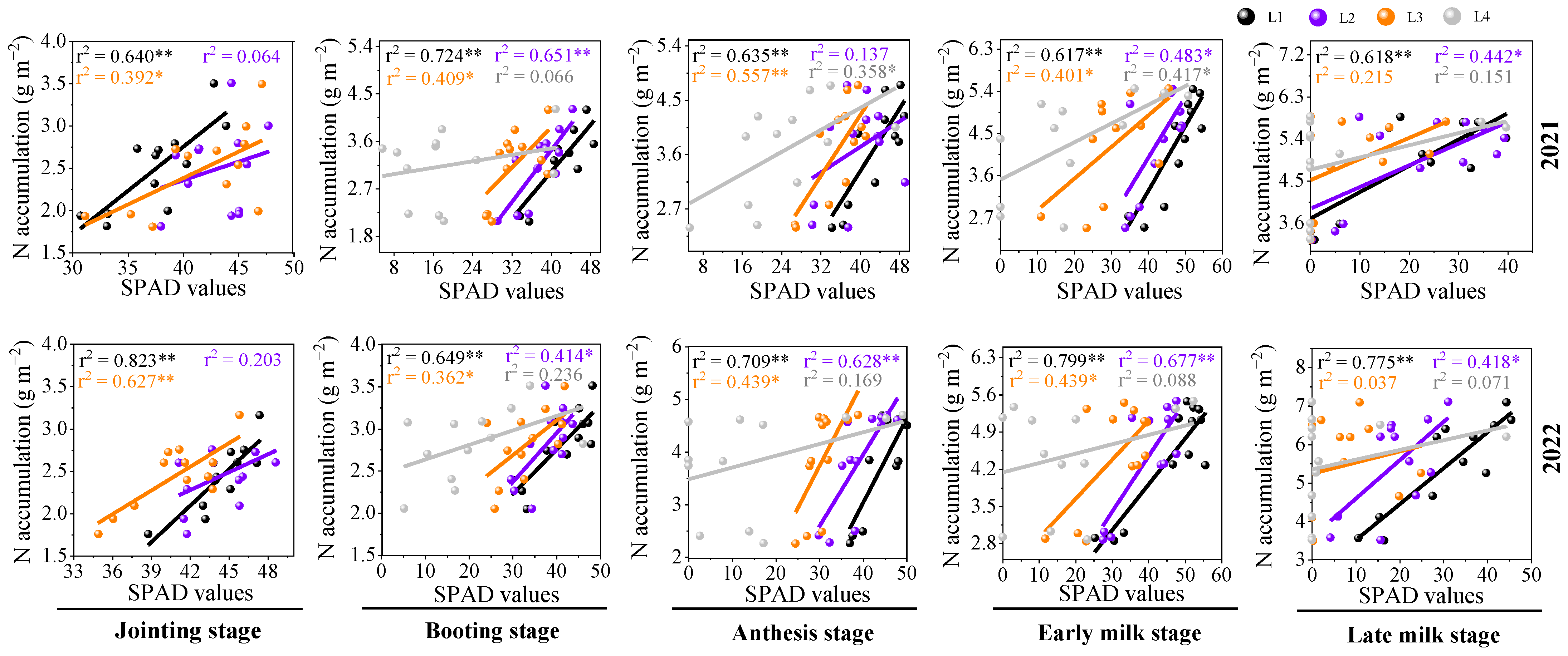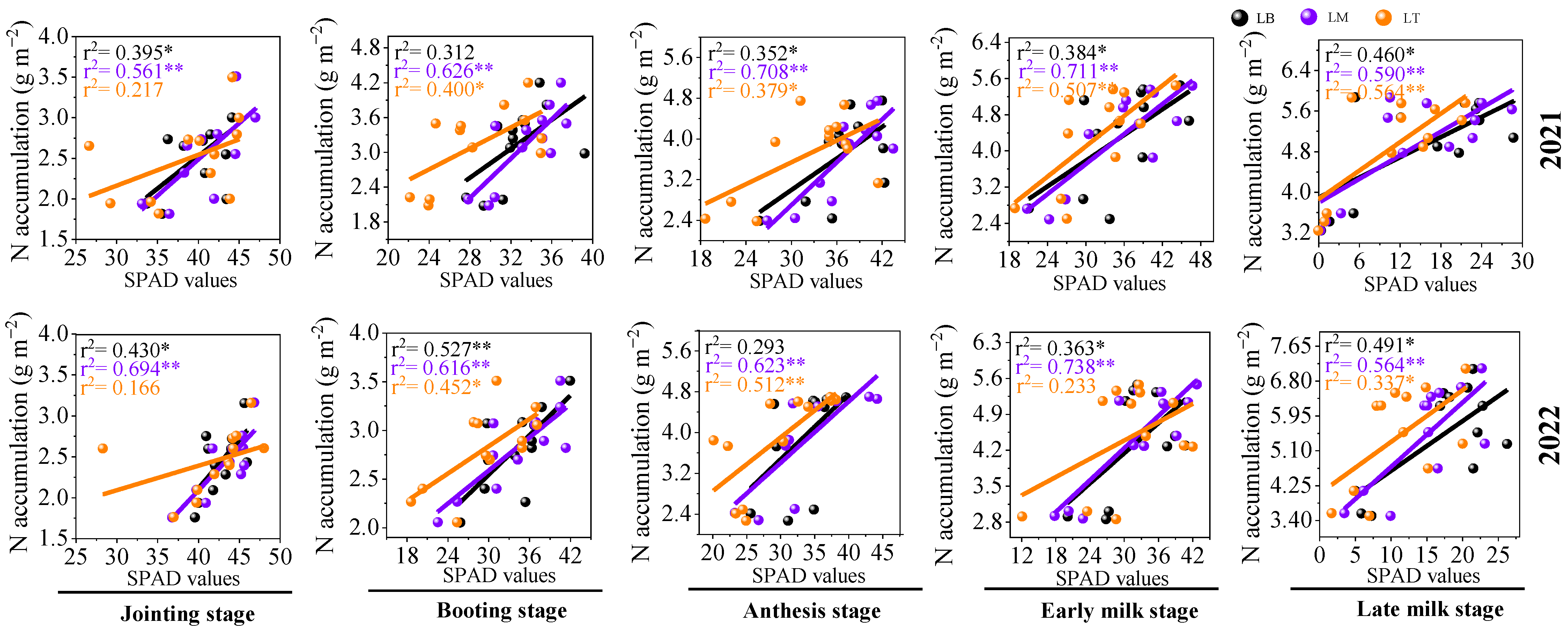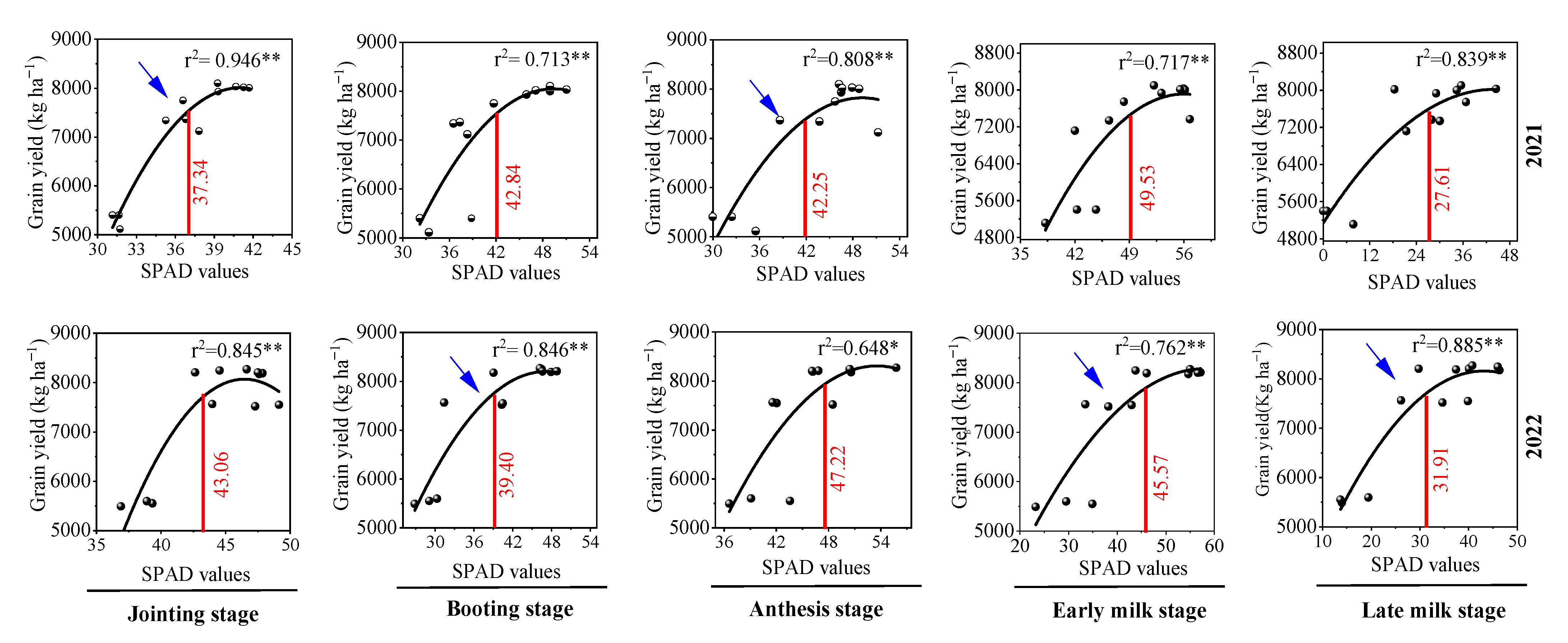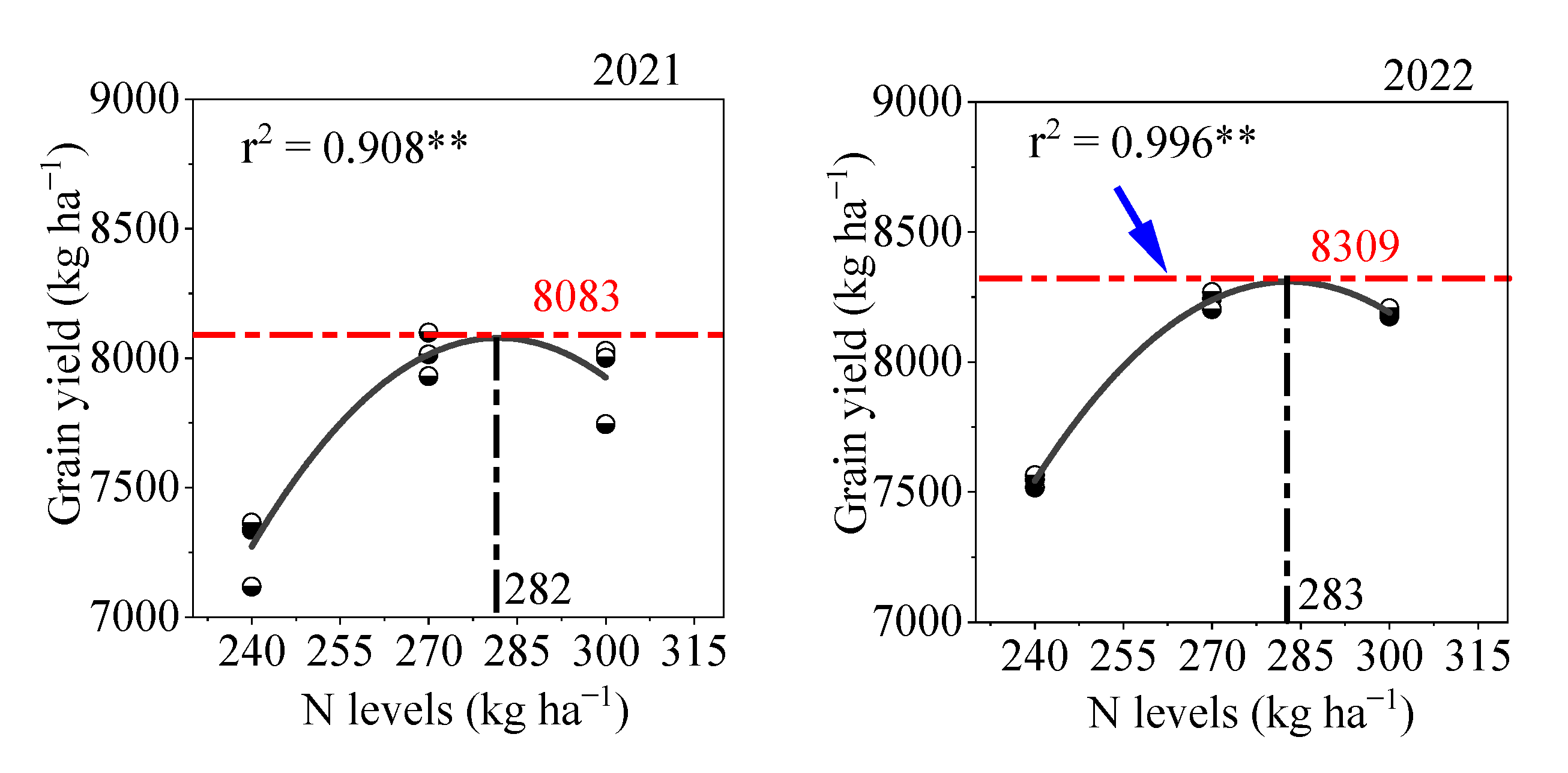Reducing and Delaying Nitrogen Recommended by Leaf Critical SPAD Value Was More Suitable for Nitrogen Utilization of Spring Wheat under a New Type of Drip-Irrigated System
Abstract
:1. Introduction
2. Materials and Methods
2.1. Experimental Conditions
2.2. Experimental Design
2.3. Sampling and Measurements
2.3.1. The SPAD Values of Wheat Leaves
2.3.2. N Accumulation and NNI
2.3.3. Grain Yield
2.4. Statistical Analysis
3. Results and Discussion
3.1. The SPAD Value of L1 Was More Accurate in Evaluating the Nitrogen Nutritional Status of Each Growth Stage under TR6S
3.2. The SPAD Value in the LM Was More Accurate in Evaluating the Nitrogen Nutritional Status of Wheat under TR6S
3.3. The Determination of Wheat Critical SPAD Value Based on the Middle of First Top Leaf (L1-M)
3.4. Nitrogen Fertilizer Recommendation as per Wheat Growth Stage Based on Critical SPAD Value
3.5. Comparison of Recommended Fertilization Strategy with Conventional Fertilization Strategy and the Evaluation of Recommended Fertilization Strategy Using NNI
4. Conclusions
Supplementary Materials
Author Contributions
Funding
Data Availability Statement
Acknowledgments
Conflicts of Interest
References
- Lv, Z.; Diao, M.; Li, W.; Cai, J.; Zhou, Q.; Wang, X.; Dai, T.; Cao, W.; Jiang, D. Impacts of lateral spacing on the spatial variations in water use and grain yield of spring wheat plants within different rows in the drip irrigation system. Agric. Water Manag. 2019, 212, 252–261. [Google Scholar] [CrossRef]
- Wan, W.; Li, L.; Jing, J.; Diao, M.; Lv, Z.; Li, W.; Wang, J.; Li, Z.; Wang, X.; Jiang, D. Narrowing row space improves productivity and profit of enlarged lateral space drip irrigated spring wheat system in Xinjiang, China. Field Crops Res. 2022, 280, 108474. [Google Scholar] [CrossRef]
- Chen, R.; Cheng, W.; Cui, J.; Liao, J.; Fan, H.; Zheng, Z.; Ma, F. Lateral spacing in drip-irrigated wheat: The effects on soil moisture, yield, and water use efficiency. Field Crops Res. 2015, 179, 52–62. [Google Scholar] [CrossRef]
- Deng, X.P.; Shan, L.; Zhang, H.; Turner, N.C. Improving agricultural water use efficiency in arid and semiarid areas of China. Agric. Water Manag. 2006, 80, 23–40. [Google Scholar] [CrossRef]
- Gan, Y.; Siddique, K.; Turner, N.; Li, X.; Niu, J.; Yang, C.; Liu, L.; Chai, Q. Ridge-furrow mulching systems-an innovative technique for boosting crop productivity in semiarid rain-fed environments. Adv. Agron. 2013, 118, 429–476. [Google Scholar] [CrossRef]
- Zhang, G.; Liu, C.; Xiao, C.; Xie, R.; Ming, B.; Hou, P.; Liu, G.; Wu, W.; Shen, D.; Wang, K.; et al. Optimizing water use efficiency and economic return of super high yield spring maize under drip tube and plastic mulching in arid areas of China. Field Crops Res. 2017, 211, 137–146. [Google Scholar] [CrossRef]
- Si, Z.; Zain, M.; Mehmood, F.; Wang, G.; Gao, Y.; Duan, A. Effects of nitrogen application rate and irrigation regime on growth, yield, and water-nitrogen use efficiency of drip-irrigated winter wheat in the North China Plain. Agric. Water Manag. 2020, 231, 106002. [Google Scholar] [CrossRef]
- Tan, Y.; Xu, C.; Liu, D.; Wu, W.; Lal, R.; Meng, F. Effects of optimized N fertilization on greenhouse gas emission and crop production in the North China Plain. Field Crops Res. 2017, 205, 135–146. [Google Scholar] [CrossRef]
- Liang, H.; Wang, S.; Wei, S. Nitrate distribution and accumulation in deep unsaturated zone soils in piedmont of North China Plain. Soils 2017, 49, 1179–1186. [Google Scholar] [CrossRef]
- Wang, S.; Tang, C.; Song, X.; Yuan, R.; Han, Z.; Pan, Y. Factors contributing to nitrate contamination in a groundwater recharge area of the North China Plain. Hydrol. Process. 2016, 30, 2271–2285. [Google Scholar] [CrossRef]
- Feng, W.; He, L.; Zhang, H.Y.; Guo, B.B.; Zhu, Y.J.; Wang, C.Y.; Guo, T.C. Assessment of plant nitrogen status using chlorophyll fluorescence parameters of the upper leaves in winter wheat. Eur. J. Agron. 2015, 64, 78–87. [Google Scholar] [CrossRef]
- Justes, E.; Mary, B.; Meynard, J.M.; Machet, J.M.; Thelier-Huché, L. Determination of a critical nitrogen dilution curve for winter wheat crops. Ann. Bot. 1994, 74, 397–407. [Google Scholar] [CrossRef]
- Peng, X.; Liu, Q.; Wang, J.; Diao, M. Nitrogen nutrition diagnosis based on the critical nitrogen concentration of drip irrigation spring wheat. J. Triticeae Crops 2015, 35, 1009–1015. [Google Scholar] [CrossRef]
- Wan, W.; Guo, P.; Hu, Y.; Zhang, X.; Zhang, K.; Diao, M. Distribution and yield of spring wheat under drip irrigation in Xinjiang. J. Soil Water Conserv. 2018, 32, 166–174. [Google Scholar] [CrossRef]
- Plénet, D.; Lemaire, G. Relationships between dynamics of nitrogen uptake and dry matter accumulation in maize crops. Determination of critical N concentration. Plant Soil 1999, 216, 65–82. [Google Scholar] [CrossRef]
- Sheehy, J.E.; Dionora, M.J.A.; Mitchell, P.L.; Peng, S.; Cassman, K.G.; Lemaire, G.; Williams, R.L. Critical nitrogen concentrations: Implications for high-yielding rice (Oryza sativa L.) cultivars in the tropics. Field Crops Res. 1998, 59, 31–41. [Google Scholar] [CrossRef]
- Colnenne, C.; Meynard, J.M.; Reau, R.; Justes, E.; Merrien, A. Determination of a critical nitrogen dilution curve for winter oilseed rape. Ann. Bot. 1998, 81, 311–317. [Google Scholar] [CrossRef]
- Wei, C.Z.; Zhang, F.S.; Zhu, H.M.; Hou, Z.A.; Guo, G.S.; Bao, B.Y. Study on cotton nitrogen diagnosis and topdressing recommendation in North Xinjiang, China. Agric. Sci. China 2002, 1, 1358–1364. [Google Scholar] [CrossRef]
- Li, Z.; Liu, H.; Zhang, F. Research of nitrogen nutrition status for winter wheat based on chlorophyll meter. Plant Nutr. Fertil. Sci. 2003, 9, 401–405. [Google Scholar] [CrossRef]
- Li, Z.; Wang, X.; Zhang, F. Diagnosis of nitrogen nutrition of several main crops in North China research on recommendation of topdressing IV. Study on nitrogen diagnosis and fertilization recommendation under winter wheat-summer maize rotation system. Plant Nutr. Fertil. Sci. 1997, 4, 357–362. [Google Scholar] [CrossRef]
- Li, Z.; Zhang, F.; Wang, X. Diagnosis of nitrogen nutrition of several main crops in North China research on recommendation of topdressing III. Study on nitrogen nutrition diagnosis and topdressing recommendation system of spring wheat. Plant Nutr. Fertil. Sci. 1997, 4, 349–356. [Google Scholar]
- Duru, M. Evaluation of chlorophyll meter to assess nitrogen status of cocksfoot sward. J. Plant Nutr. 2002, 25, 275–286. [Google Scholar] [CrossRef]
- Chapman, S.C.; Barreto, H.J. Using a chlorophyll meter to estimate specific leaf nitrogen of tropical maize during vegetative growth. Agron. J. 1997, 89, 557–562. [Google Scholar] [CrossRef]
- Debaeke, P.; Rouet, P.; Justes, E. Relationship between the normalized SPAD index and the nitrogen nutrition index: Application to durum wheat. J. Plant Nutr. 2006, 29, 75–92. [Google Scholar] [CrossRef]
- Ziadi, N.; Brassard, M.; Bélanger, G.; Claessens, A.; Tremblay, N.; Cambouris, A.N.; Nolin, M.C.; Parent, L.É. Chlorophyll measurements and nitrogen nutrition index for the evaluation of corn nitrogen status. Agron. J. 2008, 100, 1264–1273. [Google Scholar] [CrossRef]
- Monostori, I.; Árendás, T.; Hoffman, B.; Galiba, G.; Gierczik, K.; Szira, F. Relationship between spad value and grain yield can be affected by cultivar, environment and soil nitrogen content in wheat. Euphytica 2016, 211, 103–112. [Google Scholar] [CrossRef]
- Shi, L.; Zhai, Y.; Wang, X.; Hou, Z.; Ye, J. Recommendation model of nitrogen fertilizer based on SPAD of leaves for drip-irrigated spring wheat. Agric. Res. Arid Areas 2017, 35, 103–107. [Google Scholar] [CrossRef]
- Liu, Q.; Diao, M.; Wang, J.; Wang, X. Effect of nitrogen application on accumulation of dry matter and nitrogen, yield of spring wheat under drip irrigation. J. Triticeae Crops 2013, 33, 722–726. [Google Scholar] [CrossRef]
- Jin, X.L.; Diao, W.Y.; Xiao, C.H.; Wang, F.Y.; Chen, B.; Wang, K.R.; Li, S.K. Estimation of wheat nitrogen status under drip irrigation with canopy spectral indices. J. Agric. Sci. 2014, 153, 1281–1291. [Google Scholar] [CrossRef]
- Wang, H.; Guo, Z.; Shi, Y.; Zhang, Y.; Yu, Z. Impact of tillage practices on nitrogen accumulation and translocation in wheat and soil nitrate-nitrogen leaching in drylands. Soil Tillage Res. 2015, 153, 20–27. [Google Scholar] [CrossRef]
- Errecart, P.M.; Agnusdei, M.G.; Lattanzi, F.A.; Marino, M.A. Leaf nitrogen concentration and chlorophyll meter readings as predictors of tall fescue nitrogen nutrition status. Field Crops Res. 2012, 129, 46–58. [Google Scholar] [CrossRef]
- Ziadi, N.; Bélanger, G.; Claessens, A.; Lefebvre, L.; Tremblay, N.; Cambouris, A.N.; Nolin, M.C.; Parent, L.É. Plant-based diagnostic tools for evaluating wheat nitrogen status. Crop Sci. 2010, 50, 2580–2590. [Google Scholar] [CrossRef]
- Li, F.; Zhao, C.; Wang, J.; Zhang, X.; Liu, L.; Yang, T.; Shi, J.; Cao, W. Diagnosis of nitrogen nutrition of flue-cured tobacco with chlorophyll meter. J. Plant Nutr. Fertil. Sci. 2007, 13, 136–142. [Google Scholar]
- Wang, L.; Lu, Y.; Bai, Y. Research progress on nitrogen nutrition diagnosis method based on SPAD for main grain crops. Chin. J. Plant Nutr. Fertil. 2022, 28, 546–554. [Google Scholar] [CrossRef]
- Hu, Y.; Wan, W.; Wang, J.; Diao, M. Effects of different water and nitrogen application rates on the accumulation and translocation of nitrogen and yield of spring wheat under drip irrigation. Chin. J. Shihezi Univ. Nat. Sci. 2018, 36, 448–456. [Google Scholar] [CrossRef]
- Gaju, O.; Allard, V.; Martre, P.; Le Gouis, J.; Moreau, D.; Bogard, M.; Hubbart, S.; Foulkes, M.J. Nitrogen partitioning and remobilization in relation to leaf senescence, grain yield and grain nitrogen concentration in wheat cultivars. Field Crops Res. 2014, 155, 213–223. [Google Scholar] [CrossRef]
- Nehe, A.S.; Misra, S.; Murchie, E.H.; Chinnathambi, K.; Tyagi, B.S.; Foulkes, M.J. Nitrogen partitioning and remobilization in relation to leaf senescence, grain yield and protein concentration in Indian wheat cultivars. Field Crops Res. 2020, 251, 107778. [Google Scholar] [CrossRef]
- Zhang, Y.; Wang, J.; Gong, S.; Xu, D.; Sui, J. Nitrogen fertigation effect on photosynthesis, grain yield and water use efficiency of winter wheat. Agric. Water Manag. 2017, 179, 277–287. [Google Scholar] [CrossRef]
- Mon, J.; Bronson, K.F.; Hunsaker, D.J.; Thorp, K.R.; White, J.W.; French, A.N. Interactive effects of nitrogen fertilization and irrigation on grain yield, canopy temperature, and nitrogen use efficiency in overhead sprinkler-irrigated durum wheat. Field Crops Res. 2016, 191, 54–65. [Google Scholar] [CrossRef]
- Albrizio, R.; Todorovic, M.; Matic, T.; Stellacci, A.M. Comparing the interactive effects of water and nitrogen on durum wheat and barley grown in a Mediterranean environment. Field Crops Res. 2010, 115, 179–190. [Google Scholar] [CrossRef]
- Dar, E.A.; Brar, A.S.; Mishra, S.K.; Singh, K.B. Simulating response of wheat to timing and depth of irrigation water in drip irrigation system using CERES-Wheat model. Field Crops Res. 2017, 214, 149–163. [Google Scholar] [CrossRef]
- Wang, H.; Zhang, Y.; Chen, A.; Liu, H.; Zhai, L.; Lei, B.; Ren, T. An optimal regional nitrogen application threshold for wheat in the North China Plain considering yield and environmental effects. Field Crops Res. 2017, 207, 52–61. [Google Scholar] [CrossRef]
- Wang, J.; Zhang, Y.; Gong, S.; Xu, D.; Juan, S.; Zhao, Y. Evapotranspiration, crop coefficient and yield for drip-irrigated winter wheat with straw mulching in North China Plain. Field Crops Res. 2018, 217, 218–228. [Google Scholar] [CrossRef]
- Ortuzar-Iragorri, M.; Alonso, A.; Castellón, A.; Besga, G.; Estavillo, J.; Aizpurua, A. N-tester use in soft winter wheat. Agron. J. 2005, 97, 1380. [Google Scholar] [CrossRef]







| Depth (cm) | Soil Texture | pH | Water Capacity (%) | Total Porosity (%) | Soil Organic Matter (g kg−1) | Bulk Density (g kg−1) | Available N (mg kg−1) | Olsen-P (mg kg−1) | Available K (mg kg−1) |
|---|---|---|---|---|---|---|---|---|---|
| 0–20 | loam | 7.61 | 26.9 | 45.5 | 11.4 | 1.23 | 42.1 | 13.8 | 295 |
| 20–40 | loam | 7.57 | 25.6 | 45.1 | 10.9 | 1.27 | 41.5 | 13.2 | 288 |
| 40–60 | loam | 7.68 | 25.1 | 44.6 | 10.3 | 1.31 | 40.7 | 12.5 | 280 |
| Growth Stages | A | B | The Modal of Recommended Rate | Recommended Nitrogen Rate (kg/ha−1) |
|---|---|---|---|---|
| Jointing stage | 31.37 | 0.028 | N = 1403.4 − SPAD/0.028 | 69.4 |
| Booting stage | 28.238 | 0.055 | N = 796.4 − SPAD/0.055 | 80.0 |
| Anthesis stage | 32.638 | 0.05 | N = 935.8 − SPAD/0.05 | 90.8 |
| Early milk stage | 28.122 | 0.073 | N = 668.2 − SPAD/0.073 | 44.0 |
| Late milk stage | 2.265 | 0.107 | N = 304.2 − SPAD/0.107 | 6.0 |
Publisher’s Note: MDPI stays neutral with regard to jurisdictional claims in published maps and institutional affiliations. |
© 2022 by the authors. Licensee MDPI, Basel, Switzerland. This article is an open access article distributed under the terms and conditions of the Creative Commons Attribution (CC BY) license (https://creativecommons.org/licenses/by/4.0/).
Share and Cite
Wan, W.; Zhao, Y.; Xu, J.; Liu, K.; Guan, S.; Chai, Y.; Cui, H.; Wu, P.; Diao, M. Reducing and Delaying Nitrogen Recommended by Leaf Critical SPAD Value Was More Suitable for Nitrogen Utilization of Spring Wheat under a New Type of Drip-Irrigated System. Agronomy 2022, 12, 2331. https://doi.org/10.3390/agronomy12102331
Wan W, Zhao Y, Xu J, Liu K, Guan S, Chai Y, Cui H, Wu P, Diao M. Reducing and Delaying Nitrogen Recommended by Leaf Critical SPAD Value Was More Suitable for Nitrogen Utilization of Spring Wheat under a New Type of Drip-Irrigated System. Agronomy. 2022; 12(10):2331. https://doi.org/10.3390/agronomy12102331
Chicago/Turabian StyleWan, Wenliang, Yanhui Zhao, Jing Xu, Kaige Liu, Sihui Guan, Yaqian Chai, Hongxing Cui, Pei Wu, and Ming Diao. 2022. "Reducing and Delaying Nitrogen Recommended by Leaf Critical SPAD Value Was More Suitable for Nitrogen Utilization of Spring Wheat under a New Type of Drip-Irrigated System" Agronomy 12, no. 10: 2331. https://doi.org/10.3390/agronomy12102331




